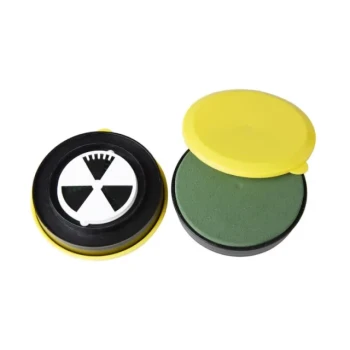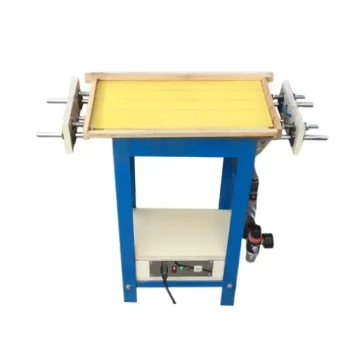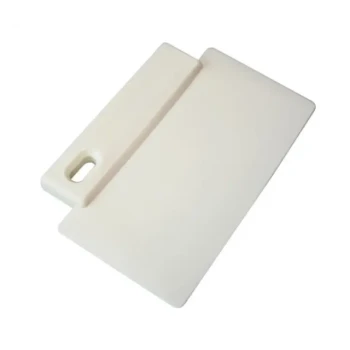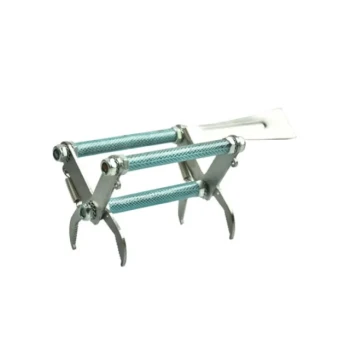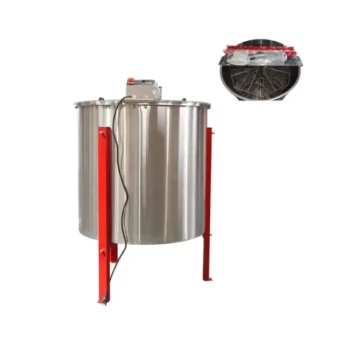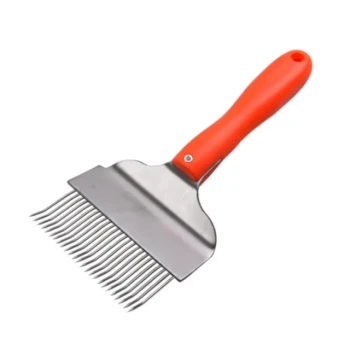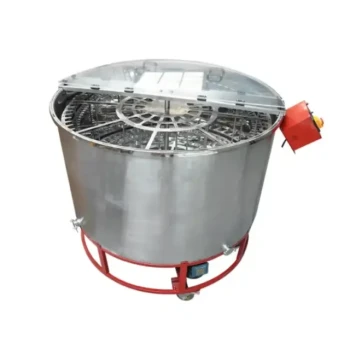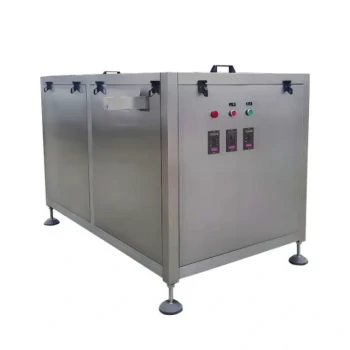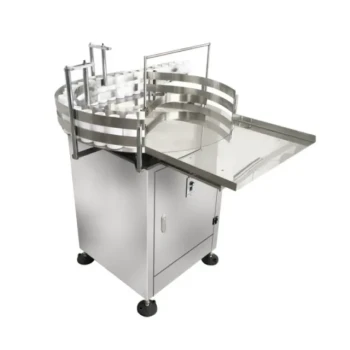In short, the vaporization method uses a specialized tool to heat oxalic acid crystals into a gas that fills the beehive to treat for Varroa mites. This fumigation process allows beekeepers to treat a colony without opening the hive, making it an extremely effective and efficient method, especially during cold weather when bees are clustered.
The core advantage of vaporization is its ability to effectively treat a hive with minimal disturbance to the bees and brood. While it is faster and gentler than other methods, it requires specialized equipment and non-negotiable safety precautions to protect the beekeeper from harmful vapor.
How Does Oxalic Acid Vaporization Work?
The method, also known as sublimation, is a precise chemical and physical process that turns a solid directly into a gas.
The Sublimation Process
A small, pre-measured amount of oxalic acid dihydrate crystals is placed into a specialized heating device, often called a vaporizer or wand. The vaporizer is inserted into the hive entrance. It first heats to about 100°C (212°F) to burn off any water, leaving pure, anhydrous oxalic acid. As the temperature rises to approximately 157°C (315°F), the solid crystals sublimate, transforming directly into a hot gas.
Dispersal and Action Inside the Hive
This hot gas, or vapor, expands to fill the entire hive cavity. It is not intended to coat the bees directly during this phase. As the vapor cools, it re-solidifies, forming microscopic, spiky oxalic acid crystals on every surface inside the hive—the bees, the comb, and the hive walls. When Varroa mites come into contact with these sharp crystals, they are killed.
The Core Advantages of Vaporization
Compared to the primary alternative—the dribble method—vaporization offers several distinct benefits for the beekeeper and the colony.
Minimal Hive Disturbance
The single greatest advantage is that you do not have to open the hive. This is critical for late fall or winter treatments when breaking the cluster's propolis seal and exposing the brood to cold air could be detrimental to the colony's survival.
Gentler on Bees and Brood
The vaporization method is considered less harsh on the bees' bodies than the dribble method. The dribble method uses a sugar syrup solution that can damage the bees' protective outer cuticle, making vaporization a gentler option for the colony's overall health.
Speed and Efficiency
Treating a hive with a vaporizer is a very quick process, often taking only a few minutes per colony. This makes it a highly efficient method for beekeepers managing multiple hives.
Understanding the Trade-offs: Vaporization vs. Dribble
Choosing a treatment method involves weighing the pros and cons based on your specific situation, equipment, and climate.
What is the Dribble Method?
The dribble method involves mixing oxalic acid with a 1:1 sugar water solution. This liquid is then applied using a large syringe, dribbling it directly onto the bees between the frames where they are clustered.
When to Choose Dribble
The dribble method does not require a specialized vaporizer, making its initial equipment cost lower. It is a viable option for beekeepers with only a few hives, but it requires opening the hive in colder weather and is generally considered harsher on the bees if used repeatedly.
When to Choose Vaporization
Vaporization is the superior choice for treating colonies during a broodless period in cold weather. Its low-impact, no-open-hive approach protects the colony from stress while delivering a highly effective treatment.
Critical Safety Precautions
The effectiveness of vaporization comes with a significant responsibility for the beekeeper's personal safety. Oxalic acid vapor is highly corrosive and dangerous if inhaled.
The Risk of Inhalation
When heated, oxalic acid vapor can cause severe damage to the respiratory tract and lungs. Never perform a vaporization treatment without proper respiratory protection.
Essential Personal Protective Equipment (PPE)
You must use a properly rated respirator with acid gas cartridges. While some sources mention N95 masks, these are for particulates and are insufficient. A half-mask or full-face respirator is the correct tool for the job. Always wear safety goggles and gloves.
Application Best Practices
Always stand upwind of the hive during treatment. Ensure the hive is well-sealed with foam or cloth at the entrance and any other gaps to prevent vapor from leaking out while the treatment is active.
Making the Right Choice for Your Apiary
Your decision should be based on your climate, the number of hives you manage, and your commitment to safety protocols.
- If your primary focus is treating during cold weather with minimal bee disturbance: Vaporization is the ideal method for its effectiveness and low impact on the colony.
- If you have a very small number of hives and want the lowest equipment cost: The dribble method can work, but understand its limitations and be cautious not to overuse it.
- If your absolute priority is personal safety: You must invest in and correctly use a respirator with acid gas cartridges, especially when choosing the vaporization method.
Ultimately, understanding the principles of each method empowers you to protect your bees from mites effectively and responsibly.
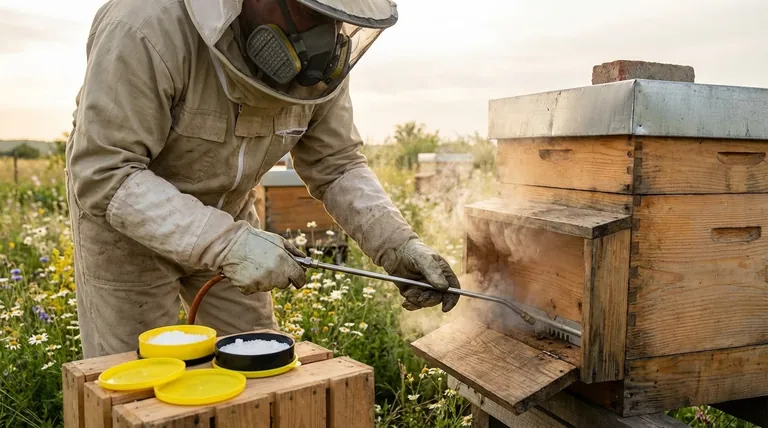
Summary Table:
| Feature | Vaporization Method | Dribble Method |
|---|---|---|
| Hive Disturbance | Minimal (no hive opening) | High (requires opening hive) |
| Impact on Bees & Brood | Gentler | Harsher |
| Best for Cold Weather | Yes, ideal for broodless periods | Less suitable |
| Equipment Needed | Specialized vaporizer | Syringe |
| Safety Requirement | High (respirator with acid gas cartridges) | Moderate (gloves, goggles) |
Protect Your Apiary with Professional-Grade Equipment from HONESTBEE
Vaporization is a highly effective method for commercial beekeepers and distributors managing multiple hives, especially in colder climates. To perform this treatment safely and efficiently, you need reliable, durable equipment.
HONESTBEE supplies commercial apiaries and beekeeping equipment distributors with the high-quality tools required for modern, responsible beekeeping. From industrial-grade vaporizers to essential personal protective equipment (PPE), we provide the wholesale-focused solutions you need to protect your investment and ensure colony health.
Ready to equip your operation with the best? Contact HONESTBEE today to discuss your wholesale needs and discover how our supplies can enhance your mite management strategy.
Visual Guide
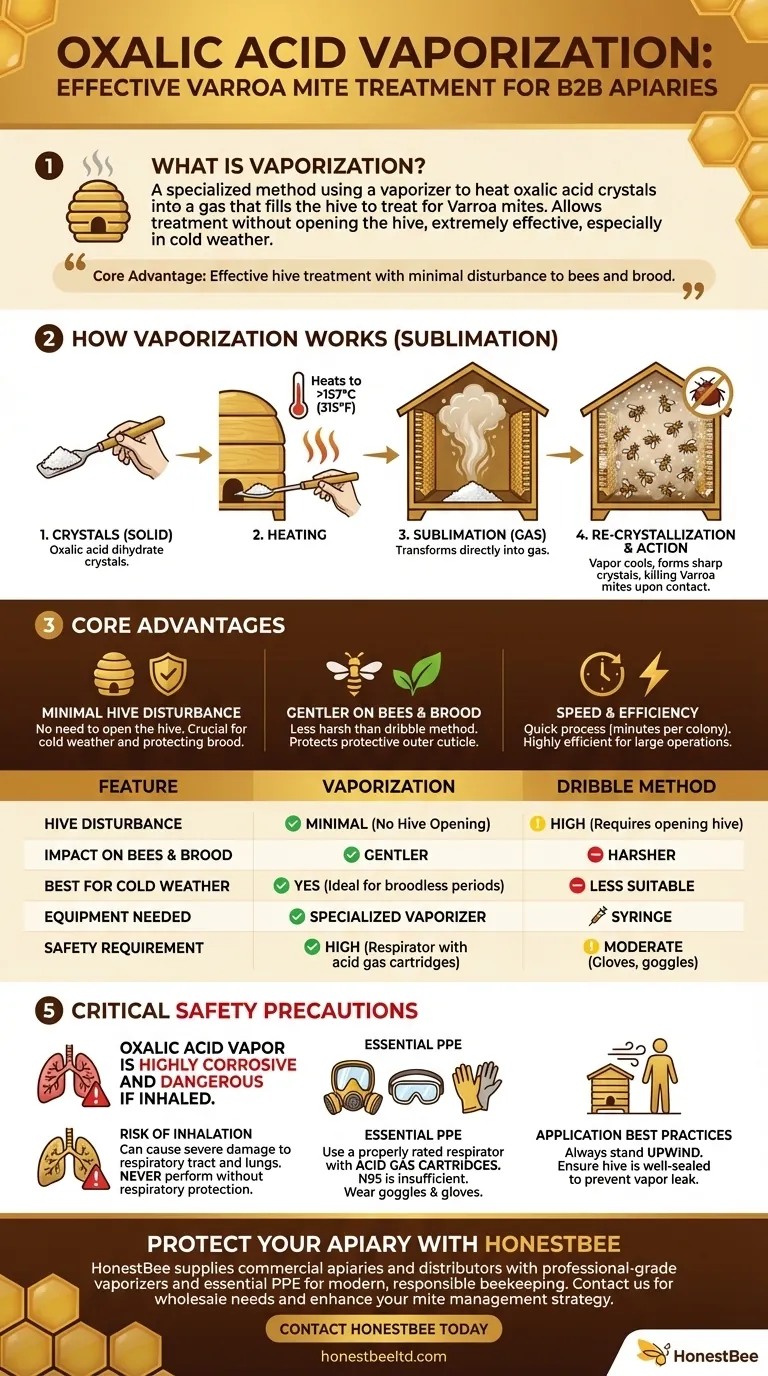
Related Products
- Adjustable Formic and Acetic Acid Dispenser for Bee Mite Treatment
- Economy Small Scale Honey Dryer Dehumidifier Thickening Machine
- High Quality Honey Dehumidifier Dryer Thickening Machine for Beekeeping
- Professional Pneumatic Wire Embedder for Beehive Frames
- Beehive Handle and Frame Rest Cutting Machine: Your Specialized Hive Machine
People Also Ask
- What are some common predators and pests that target beehives? Protect Your Hives from Bears, Mites, and Beetles
- What are the symptoms of Varroa Mite Syndrome (VMS)? Recognizing the Signs of Colony Collapse
- How can beekeepers ensure their hives survive the winter? A Guide to Colony Survival
- What does Chewed Down Brood (CDB) indicate in bee colonies? A Sign of Varroa Mite Infestation
- What is the optimal time for varroa mite control in nucs? Maximize Efficacy with Perfect Timing
